Back to main menu
THE STRANGE TELEVISION OF APOLLO

I have found an interesting article in the NASA documentation about the way the television was managed in the Apollo missions, and decided to make a document out of it, for there are many things to say about it.
Link to the document explaining how the television worked on Apollo
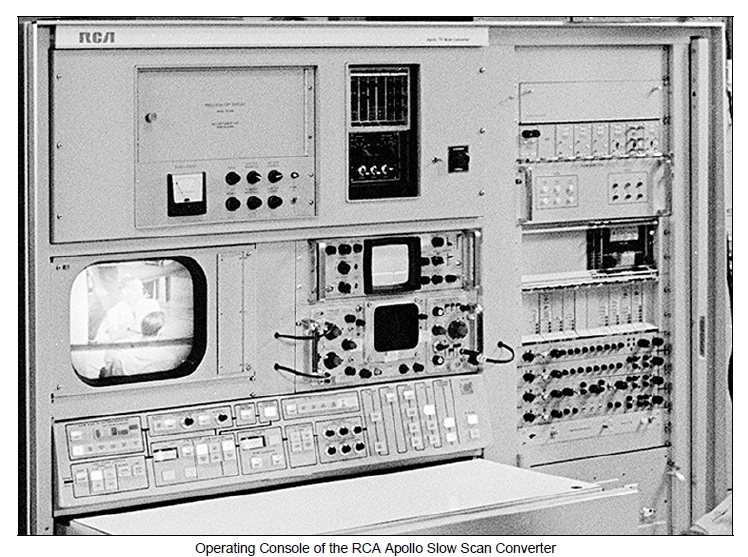
One of the problems to show the video taken by the camera of Apollo 11 on the TV was that the video which was taken by the camera of Apollo 11 was a slow scan of 10 frames of 320 lines per second while the NTSC standard was 30 frames of 525 lines; that means that the video of Apollo could not be shown as such but had to be converted to the NTSC standard.

In order to make the conversion, they were using a TK-22 camera which had two interlaced fields of 262.5 lines each.
Interlaced means that the beam makes a first scan of 262.5 lines, then goes back to the middle of the first line and makes a second scan of 262.5 lines; why to process that way? Because it improves the quality of the image, that it avoids the flickering effect which could be observed if there was a unique scan.
What they say is that, in the conversion process, they had to wait for a frame of the slow scan of the Apollo video to be completed before recording the first field of the camera, but, as the vertical retrace was very short (2.5 millisecond), they only had to the time to record the first field, and not the second interlaced one.
The vertical retrace is the moment that the first field has finished the last half line and goes back up to first half line to start the second interlaced field.
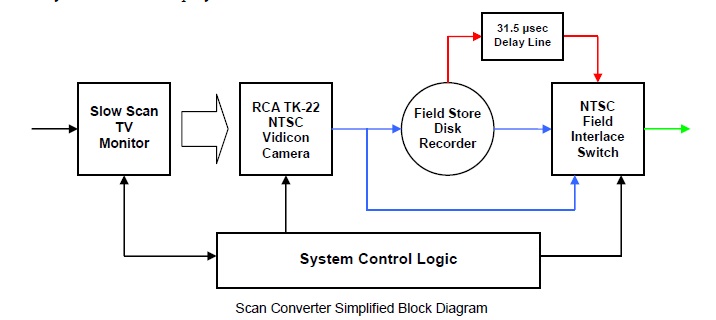
But they could not leave the second interlaced field blank, so they decided to duplicate the first recorded scan into the second interlaced field.
So, what they were doing to reconstitute the three frames of the NTSC standard which were corresponding to one frame of the Apollo slow scan video, was to record the first field, then delay by a half line the recorded field to generate the second interlaced field, and then twice more the recorded field and the delayed recorded field.
That way, they were reconstituting the Apollo video in the NTSC standard...but the problem is that the 320 lines of the original video were reduced to only 262 lines in the converted video, paradoxically implying a loss of quality, when the NTSC standard had more lines than the Apollo video!
But it is stupid, because they did not have to wait for the end of a scan of the Apollo video to record it, they could perfectly have continuously recorded it; that way there would have been no loss in quality!

The NTSC video was recorded on a 2 inch wide tape at a speed of 3.7 inches per second.
So you might think that the original Apollo video signal which covers a slower bandwidth would be recorded at a slower speed?
No, because they were recording the full original downlinked signal with the high frequency carrier, and, as the frequency of the transmitted downlinked signal is much higher, they were needing to run the tape at an insane speed of 120 inches per second!
It makes no sense, because they only needed to record the much lower frequency demodulated signal, and not the carrier of the signal which has a much higher frequency and does not contain information in itself.
No wonder if they were recording irrelevant information that they were needing tons of tape, and that they were so short of tape that, at the end of the missions they had to use the tapes of the first mission to record the last mission!
That might explain why the tapes of Apollo 11 have disappeared!

The NASA also used a Westinghouse color camera in the Apollo missions.
The problem with this camera is that it was recording the three (red, blue and green) channels separately, whereas the red blue and green signals are mixed together in the NTSC signal.
And the camera was also recording at a rate lower than the one of the NTSC standard.

So, to convert the output of the camera into the NTSC standard, they have imagined the following system, in which the camera's output was first recorded on a first tape-recorder running at the speed of the camera's output, then the output of this tape-recorder was fed into a second tape-recorder running at the speed of the NTSC standard; the three colors were periodically stored at a rate of 20 times per second, and then mixed together to reconstitute the NTSC standard.
It seems to work, but it seems only.
Indeed, the NTSC standard runs at 30 frames by second; so, if the color channels were refreshed at only 20 times per second, that means that the frames were displayed faster than the refresh of the color channels, and consequently that there were frames with only one color.

Frames with only one color may make a nice psychedelic animation, but I doubt that it allows to view the video filmed by the color camera!

They say that the LM encountered antenna pointing problems during the powered descent, and thence that the large 64 meters dish of Goldstone added with the one of Parkes (in Australia) allowed to increase the sensitivity of the reception of the downlinked signal and so to compensate for these problems.
But, if the LM really had serious problems to point its antenna toward the earth, it is not this added sensitivity which could help.

Of course, if the LM was behaving weirdly like what we see on the Apollo video, no wonder that the LM had antenna pointing problems!
The truth is that, if the guidance of the LM had been done normally, the rotation of the LM would have been slow and regular, and the LM would have had no antenna pointing problems, for it would have had plenty of time to correctly and accurately point its antenna toward the earth.
Moreover, if the LM had really been landing on the moon and behaving the way we see on the video, it would have been sure to crash on the moon!

They say that the television signal was demodulated and re-modulated along two different microwave paths in order to provide redundancy in case of failure of one link at Houston.
But why demodulate the television signal to re-modulate it again?
Why not simply retransmit the original modulated signal?
So that it could be modulated on two different carriers to provide redundancy?
But, if there had been a transmission problem between Goldstone and Houston, it would have affected the two microwave paths.
The true redundancy would have been to transmit a unique signal, but to have two reception units both tuned on this signal, so that, if one of them had a failure, the other one could still receive it.

They say that NASA engineers were sent to Parkes in Australia to help to adapt it for Apollo reception.
Oh really?
I thought that Parkes was an independent source confirming that Apollo was real.
Independent would have meant that it was independent from the NASA, which is proven wrong.
This antenna was also under the control of the NASA.

In the video of the CSM, two horizontal bars could be seen; Westinghouse would have found the origin of the problem in an internal ground loop causing color wheel motor drive variations to be induced in the video output; but these lines are too regular to be explained by this cause; in fact the color of these double bars corresponds to the background, simply lighter or dimmer; if this cause had been real, we would have seen true variations of color.

They say that, when Aldrin went into the LM, he "wiped away the moisture that had collected on the lunar module windows"!
The moisture, in this environment?
Oh I was forgetting we were on the fake moonset!
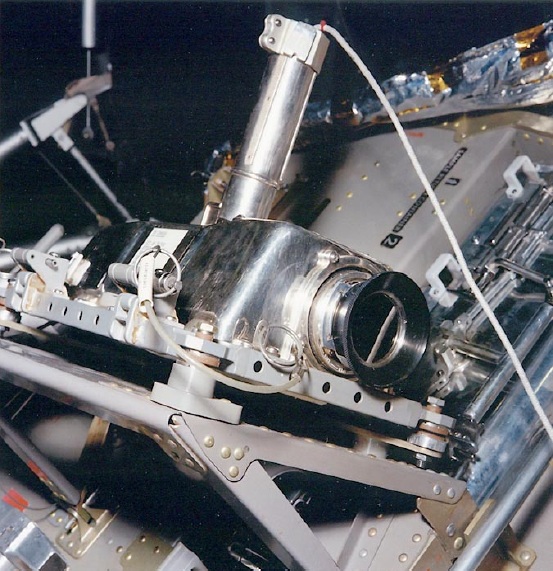
The Westinghouse lunar surface camera was placed in bias in the MESA, not completely vertical.
As a result, it was filming in bias, which explains that the lunar horizon was seen under an angle of 11 degrees (as they say it).

That's effectively what we can see on the Apollo 11 video, but, in that case, why doesn't Armstrong also appear in bias?
Does that mean that he was bending himself to correct the attitude of the camera so that he would appear vertical on the video?
What an admirable attention!

They say that the crew could have deployed an erectable S-band antenna to provide stronger signals, but, since Goldstone and Parkes 64 meters dishes were on line, it was not necessary!
Bullshit, this is no excuse; if they had the possibility of erecting an antenna to provide stronger signals, they should have done it!
There always was the possibility that a weak signal could be lost in earth's atmosphere, and even with large dishes, there would be problems of reception.

They say that Houston was connected to Goldstone's video and saw an inverted video; Houston said to the Goldstone scan converter operator to place the converter invert switch to the correct position, and the video display then appeared normal, though with a bad contrast.
Oh really, they had to tell the operator what he had to do, he could not see it by himself?
What was he doing meanwhile. Taking a nap?
It seems that "the greatest moment in history" was managed in the most unprofessional of ways!

They say that the video received from Honeysucle creek (right) was better than the one received from Goldstone (left).
But, it is not because the quality of reception was better at Honeysuckle creek than in Goldstone, the quality of reception is equivalent.
It is the contrast of the camera filming which is better adjusted on the Honeysuckle creek video than on the Goldstone video.
But it is not possible, because there was only one camera filming on the moon, and one unique video signal sent!

The Goldstone TV tech inverted the video polarity of the SS monitor, and Houston saw what is shown on the left picture of this stereoscopic view.
And after the Apollo 11 mission NASA restored the negative video to positive for archiving, they obtained a much improved picture (right of the stereoscopic view) relatively to the original image.
So, if you want to improve a video, all you have to do is to invert it and invert it again to put it to normal again?
That's original!
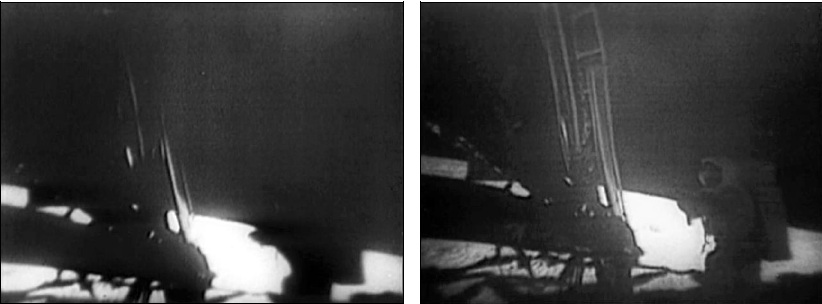
Houston saw that the image received from Parkes (right of the stereoscopic view) was much better than the image received from Goldstone (left of the stereoscopic view); so they stayed with Parkes for the rest of the EVA.
But, here, it is absolutely obvious that it is not a problem of reception of the video signal; the explanation can only be that the two scenes are lit differently.

This stereoscopic view shows, on the left, the original video, slow scan 320 lines, 10 frames per second, taken with a polaroid, and, on the right, the video converted to the NTSC standard, 525 lines, 30 frames per second, with an important loss of quality because of the aberrant way the conversion was done (described in the beginning of the document).
We can effectively see that the quality is better on the left picture, but there is however an anomaly: See the side of the ladder, it has a better contrast on the picture of the right!
How can the loss of quality provide a better contrast?
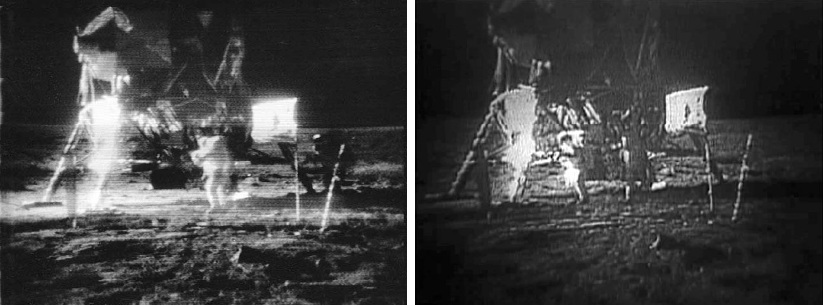
This stereoscopic view shows, on the left, a polaroid photo of the Goldstone Fairchild monitor, and, on the right, a similar scene from the NASA archive.
Again, the quality seems better on the left, but see the flag: It has a better contrast on the NASA archive than on the polaroid photo.

On Apollo 12, it now was a color camera filming, but, again in the mesa, it was placed so it was not quite vertical.
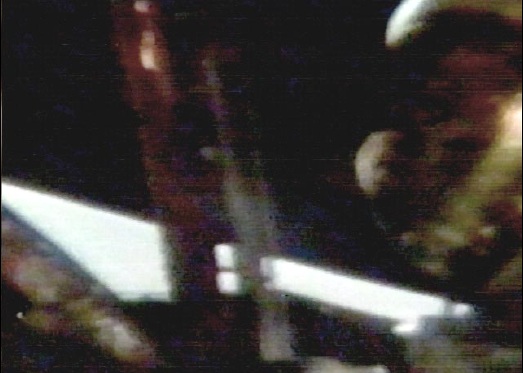
As a result, the lunar horizon was appearing with an angle, but the astronaut was strangely appearing vertical, and not in bias like he should have.
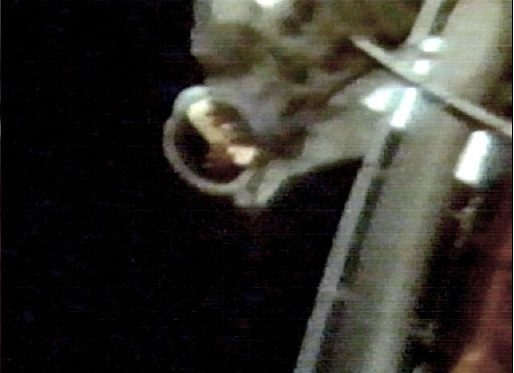
And the camera films here Alan Bean after he has flipped it out for removal.
But, why does Alan Bean appear under this strange angle and so distant?
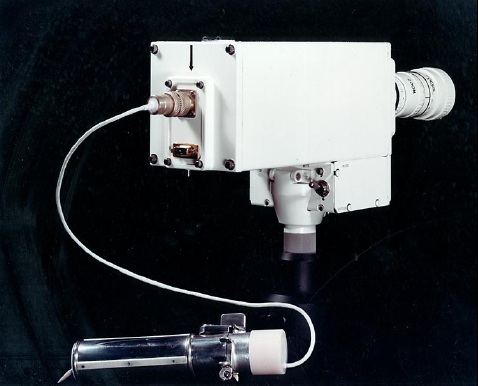
They say that the video signal was passed through a low-pass filter to separate it from the telemetry and voice subcarriers, but the video signal had a frequency (3MHZ) higher than the one of the subcarriers of the telemetry and voice (1.024MHZ and 1.25MHZ), so it is rather a high-pass filter which should have been used to eliminate the telemetry and voice signals!

They say that Bean accidentally exposed the camera to the sun (appearing in the top left corner on this image), and the sun would have harmed the camera.

Thereafter, a white area would have permanently appeared on the top of the image.

When back on earth, the camera was tested.
And effectively the white area could be seen in the image.

But in fact we don't see a fully white area; we can see strange things on it, I have circled.
And the thing on the left strangely looks like a sailboat!
They found out that, when they were cutting the light level control circuit, the image was appearing normal again.

On this schema, they explain how the image-tube target was damaged.
They even show the damage in three-dimension.
They say that the combination of the damaged image-tube target and the automatic light control action was causing the loss of picture.
Oh really? I would have thought that the simple fact of the damaged image-tube target was enough to cause the partial loss of picture!
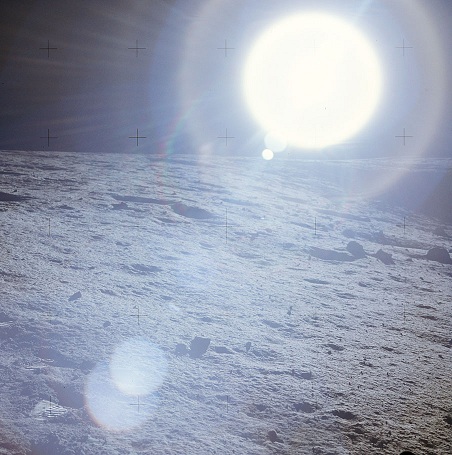
And, if the sun was so dangerous for the video camera, we may wonder how it did not burn the Hasselbald's film when the astronauts directly photographed the "sun".
So, the Hasselblad would have been well protected from the sun, but not the video camera?

To avoid this problem from happening again, they equipped the video camera with a cap, attached to the neck of the camera, that the astronaut could place when he was moving the camera to protect it from the sun.
Oh yes, that's all they have found?
They could not have found a way of protecting the tube target against a violent light instead?
And what if the astronaut forgets to place the cap (or the camera falls after he has removed the cap)?

On Apollo 14, they have tried different settings for the camera, with the camera set to "Peak" on the left of the stereoscopic view, and set to "Average" on the right.
With the camera set to "Average", the lunar ground was appearing better, but the white suits of the astronauts were appearing overexposed.

However, there is something strange: Although the scene globally appears darker on the left, the LM's shadow does not completely appear filled with dark on the left whereas it appears as such on the lighter image of the right!

Since the lunar ground was appearing better with the camera set to "Average", the ground controllers asked the astronauts to keep this setting, although their white suits were appearing overexposed.
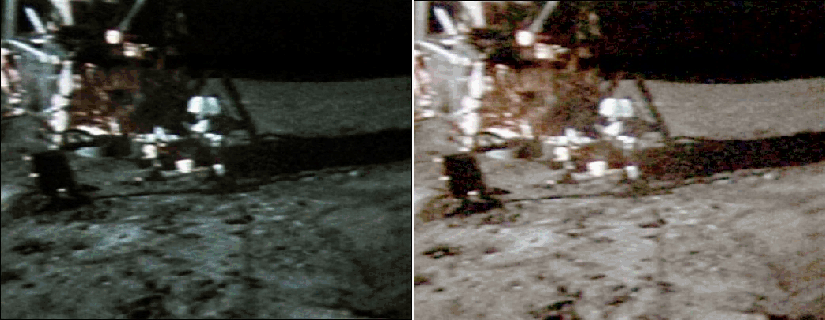
They say that they could improve the image with the camera set to "Peak" (left of the stereoscopic view) by applying a gamma correction to it (right of the stereoscopic view); but why does the gamma corrected image appear with a color different from the uncorrected one?

They say that the Westinghouse color camera used aboard the Apollo 14 CSM was not bandwidth restricted, but yet the image it was taking was not very good, rather grainy.

They say that there was a problem with the presence of the telemetry and voice subcarriers in the middle of the video bandpass at 1.024 and 1.25MHZ.
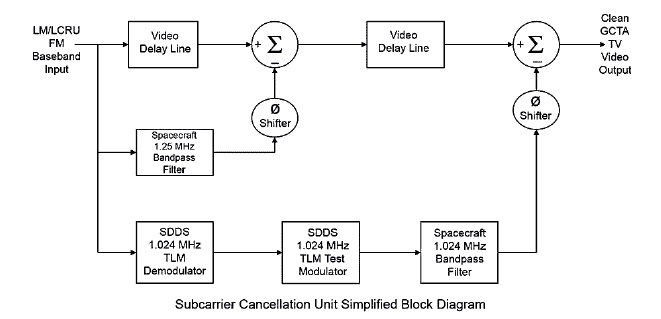
So, they had imagined a way to eliminate these bothering subcarriers by applying counter-signals to subtract these subcarriers from the signal.
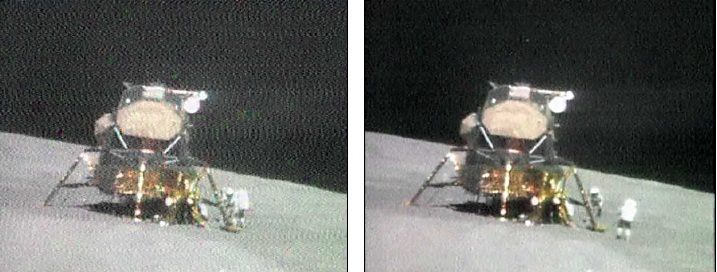
This way, they were obtaining a better signal, and they show the difference of quality they obtain by adding this subcarrier cancellation unit.

But, if they eliminate the subcarriers of the telemetry and voice, the telemetry and voice can no more be extracted from the signal!
So, it would be much simpler not to mix the telemetry and voice signals with the video signal.

In fact, there is a simple solution which allows to keep the voice and telemetry in the signal, without their subcarriers interfering with the video signal:
It would be to change the frequencies of the subcarriers of the voice and telemetry, so that they no more interfere with the video signal.
There are enough frequencies available for that purpose.

They say that the camera of Apollo 15 did not try to follow the LM in the lunar sky because the camera had elevation problems.

Yet, right after Scott had parked the rover in its final position a little before the liftoff, the camera didn't seem to have such problems, for it still could move vertically
The problem was an elevation clutch slippage when the camera was driven down near the lower stop.
But, to film the LM ascending, the camera didn't have to go down anyway, but up.
So it should not have been a problem.
And, they should have given it a try anyway, for the only risk was that it would not work.
And, even if the camera had remained stuck upward, what could it have filmed anymore in horizontal position, since there was nothing anymore mobile to see!

They found a way of improving the image by making an image transform which was consisting in combining four frames of video to make each new frame; they were privileging static portions of the picture, but that was meaning that fast motions were less well rendered.

That probably explains why the motion of the astronauts was seeming so strange, with jerky moves.

They say that, from Apollo 16, the rover's camera was able to capture the lunar's ascent stage departing from the moon's surface by careful programming of the elevation motion commands.

In that case, why does the move of the ascent module seem so strange in the liftoff of Apollo 17, with the LM going down on the image after having first gone up (and this strange horizontal sinusoid at the end of which the LM disappears from the image)!

And what about Cernan cleaning the camera's lens in Apollo 17; how could he know that dust had arrived on the camera's lens whereas he could not see the camera's video (and that Houston's operators did not warn him in the transcript of the dialog)?
And how could the dust reach the camera with no wind to project dust on it?
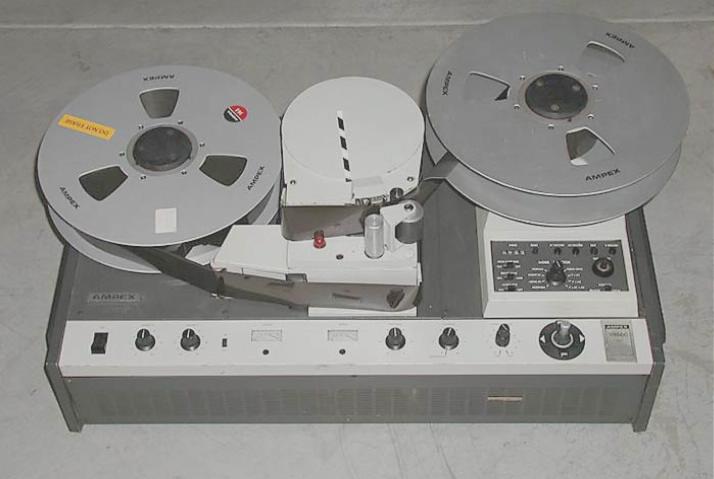
To end this document, I am going to talk about the search of the Apollo 11 missing tapes.
link to the search of the Apollo tapes
It has recently been made public that the NASA had lost the original tapes of Apollo 11.
I have found an interesting article dealing about the vain search of these tapes.
The original Apollo tapes were containing a better video than what was shown on TV at the time (because of the dumb conversion I have explained at the start of the document).
So they looked for the original video tapes, for they thought that, with the modern technology, it would be possible to make a better conversion of the video.
The Goddard personnel, thinking that the Apollo program no longer needed the data, had sent the canisters containing the tapes to WNRC for storage.

They find a slightly damaged box containing nine tapes labeled "NCG-721", and they are sure it's about Apollo.
Unfortunately they were containing Apollo 9 mission data recorded at the Canary Island tracking station in 1969.

A retiree had claimed he had dubbed the tape from the original M-22 recording as a keepsake of the historic day.
For 36 years the tape had languished in the garage of his Canberra home.
When they finally found the man and obtained the tape from him, they were full of hope, certain they would see Armstrong descend the ladder.
But, when they viewed the tape, their deception was great to see that it was only containing chatter and simulation data from october 1967.
The tape's owner said that, in the confusion of the day, he might have picked up the wrong reel!
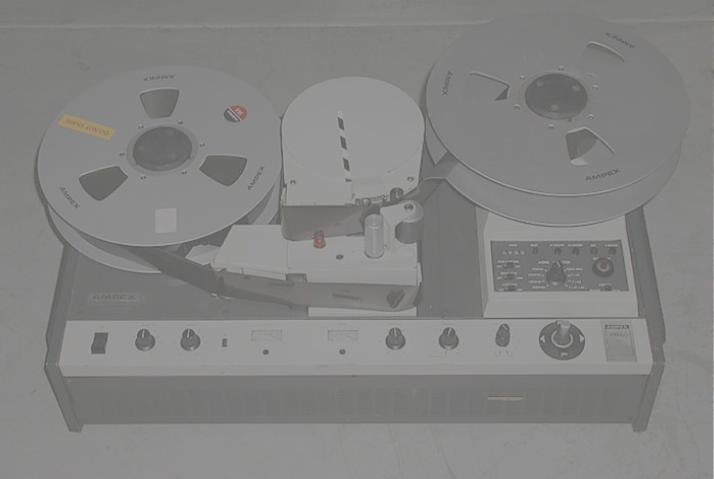
After a long search, they think they might have found videotapes and films related to the event, but the tapes were blank, and the films were containing unrelated television footage.
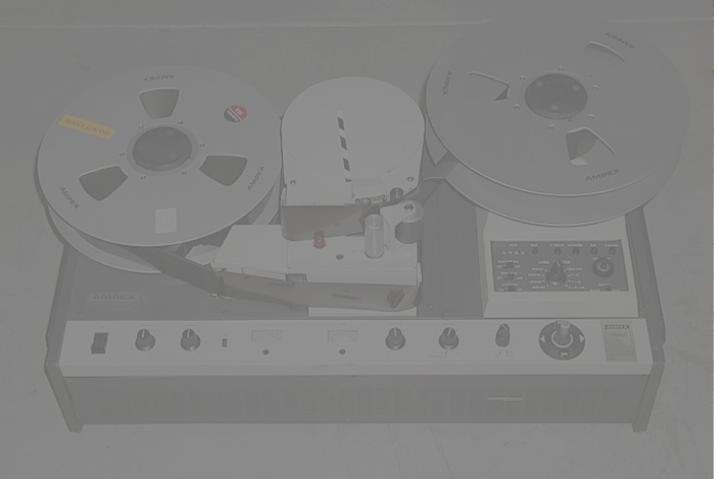
The final conclusion is that NASA was so short of magnetic tapes that it probably reused the tapes of Apollo 11 for another use.
No wonder if they were recording the full downlinked signal at an insane speed of 120 inches per second!
They were making an intensive use of magnetic tapes and, at a given moment, they had to re-use magnetic tapes which had already been used.
We'll never have quality video of the historical moment...on the fake moonset!
















































